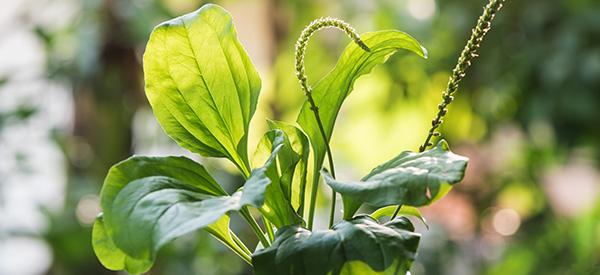
Plantain
Plantain (Plantago major), or broadleaf plantain, is a common plant typically dismissed as a weed that thrives abundantly in lawns. It has rosette leaves growing close to the ground and interestingly grows a leafless stem that bears spikes of flowers. Broadleaf plantain is also known as common plantain, greater plantain, ripple grass, or rat’s tail because of the morphological arrangement of its spikes. It is also called the white man’s footprint as it often appears anywhere around early European settlements.
The name plantain is often mistaken as the fruit plantain of the banana family, but the two are not related in any way. This flowering plant is a species from the Plantaginaceae family. It pops up everywhere as a weed, especially in man-made disturbed habitats. With its reputation as a weed, its medicinal properties are often overlooked. But the healing property of plantain is notable in the past that it was mentioned in Shakespeare’s book Romeo and Juliet.
Where The Plant Is Found
Plantain is an Old French word that means “planta” or sole of the feet. It was considered a medicinal plant and an edible green eaten similar to spinach. It was grown in monasteries and botanical gardens, where it was considered a sacred herb. It is a plant native to Europe and brought to North America by Puritan colonizers. Native Americans used the herb to treat fever, open wounds, and snake bites.
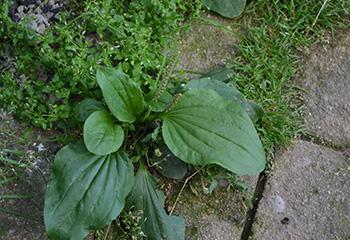 Plantago major is native to Europe, Asia, and North America. They grow in fields and roadsides, especially in places that are disturbed.
Plantago major is native to Europe, Asia, and North America. They grow in fields and roadsides, especially in places that are disturbed.
It readily grows in places that are always tramped on and even between parking lot fissures.
Plantain often thrives in dry areas but may also grow occasionally in wetlands.
Related: The Complete Map of Edible Plants: Find Out What You Have in Your Area! (Video)
How To Identify Broadleaf Plantain
The rosette set of leaves and leafless pencil-like stalk identify the common plantain. It has showy flowers that bloom around summer or springtime. Plantain proliferates in the garden and becomes hard to remove once it has established itself. It is why most people consider it as a nuisance weed, if without knowledge of its healing properties.
- Leaves. The edible leaves of broadleaf plantain are green, leathery, and rosulate. It is lanceolate to egg-shaped with an acute apex about 2 to 4 inches long and 2 to 5 inches wide. It has a major stringy vein that originates from the base of the leaf. Its lower surface has a lighter color and has fine hairs growing along the veins.
 Flower. Greater plantain has a cylindrical spike on top of its stem that grows small flowers. These flowers are greenish-brownish in color and with either white or purple stamens. It is narrow and cylindrical, densely clustered in the center of its spike.
Flower. Greater plantain has a cylindrical spike on top of its stem that grows small flowers. These flowers are greenish-brownish in color and with either white or purple stamens. It is narrow and cylindrical, densely clustered in the center of its spike.- Roots. Plantain is anchored to the ground with fibrous roots that contribute to its easy spreading. The taproot is often short, which branches out into these dense networks of fibrous roots.
- Seeds. After the plantain flowers mature, they are replaced by ovoid-shaped seed capsules. Each of these capsules contains tiny seeds that are about 6 to 15 pieces. The seeds vary from light to dark brown with a flattened surface about 1 to 1.5 mm long.
- Stems. The stem of the plantain is erect, leafless, unbranched, but flowering. It is a simple stalk that is green, round, smooth, and hairless. This stem bears the inconspicuous cluster of plantain flowers at its upper portion.
Related: Plant Identification Guide – 400 Wild Plants That You Can Forage For (Video)
Plantago major has over 265 species that are all edible and distributed across many regions. North America has about 35 species native to the locality. But the European variety is the most abundant anywhere. The common subspecies of this plant are:
- Plantago lanceolata (narrow-leaf plantain)
- Plantago rugelii (reddish-purple plantain)
- Plantago ovata (blond plantain/psyllium)
How To Grow Greater Plantain
Plantago species like the broadleaf plantain can grow in grassy and open spaces with ample sunshine. They can thrive in any type of soil, even compacted ones and disturbed places. Growing the plant requires minimal effort, and they proliferate well in USDA hardiness 3 to 9.
Broadleaf plantains are invasive, but some gardeners cultivate them for their medicinal properties. They are also useful plants in preventing soil erosion by holding the earth in place and breaking up the compressed soil. The propagation strategy of the plantain is either in root cutting or seed propagation.
Plantain seeds for planting are not commonly sold in local plant stores because they are mainly considered weeds. But some online stores do sell plantain seeds for purposes of propagation.
Growing Plantain By Seeds
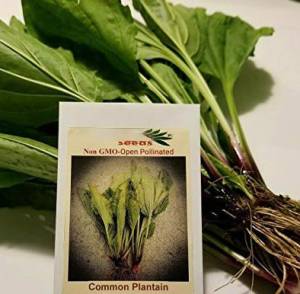 Plantain seeds can grow even if you directly sow them in the soil during spring. But if you want to increase its germination rate, cold stratifying them is not such a bad idea. Place the seeds in a Ziplock bag and allow them to cold-stratify in the refrigerator for at least four weeks.
Plantain seeds can grow even if you directly sow them in the soil during spring. But if you want to increase its germination rate, cold stratifying them is not such a bad idea. Place the seeds in a Ziplock bag and allow them to cold-stratify in the refrigerator for at least four weeks.
After sowing plantain seeds, keep the soil moist until the seedling emerges. Until then, the plant needs little intervention to proliferate.
Plantain seeds are also ready to self-sow. So, if you have an existing plant, expect them to re-grow in your garden the next growing season. Or, you may harvest the seeds after the flowering stage to plant them only in designated seedbeds.
Related: I Stopped Spending Money At The Pharmacy By Growing These 10 Plants (Video)
Growing Through Root Cutting
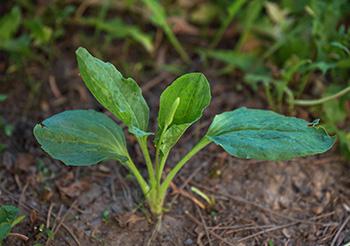 You may also spread the plant in your garden by transplanting its root cuttings. Dig up the plant with its taproot and fibrous roots intact. Plant them at the same depth where they are previously growing and keep the soil moist. Root cutting will soon grow into a new patch for your plantain to proliferate. The plant is best planted in areas where the soil is easily eroded so you can get the most out of its erosion prevention benefit.
You may also spread the plant in your garden by transplanting its root cuttings. Dig up the plant with its taproot and fibrous roots intact. Plant them at the same depth where they are previously growing and keep the soil moist. Root cutting will soon grow into a new patch for your plantain to proliferate. The plant is best planted in areas where the soil is easily eroded so you can get the most out of its erosion prevention benefit.
Related: 10 Plants That You Should Never Plant Together (Video)
Plant Care
When the plantain root has fully established itself, it hardly needs any maintenance at all. It is even self-fertilizing and self-sowing. But if you want a lush and healthy growth of your broadleaf plantain, here are some helpful tips:
- Plant them in a frequently treaded area.
- Plantain prefers areas with full or partial sun.
- Regular mowing is beneficial for encouraging growth and keeping them under control.
- Grow them in one part of the garden to easily handle their invasiveness.
- If there are bugs and aphid infestation, apply a strong spray of water from a hose.
How To Harvest Plantain
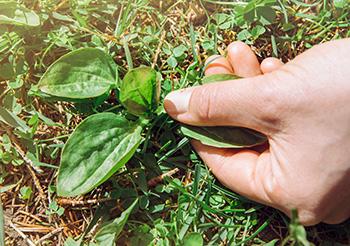 You can harvest plantain leaves anytime during its growing season, but it depends on how you will be using them. For example, if you want to use it in salads, you can gather the tender part of the leaves during early spring. Mature leaves may be cooked and steamed, but they tend to be fibrous than the younger ones.
You can harvest plantain leaves anytime during its growing season, but it depends on how you will be using them. For example, if you want to use it in salads, you can gather the tender part of the leaves during early spring. Mature leaves may be cooked and steamed, but they tend to be fibrous than the younger ones.
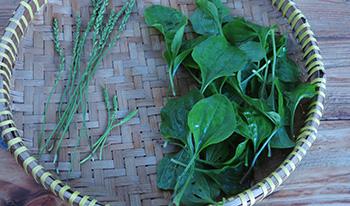 If you want to make tinctures, harvest the leaves during the early season. The young seed heads that are abundant during summer are best for incorporating into a stir-fry. Both leaves and seeds of plantain can be used fresh or dried and be frozen for later use.
If you want to make tinctures, harvest the leaves during the early season. The young seed heads that are abundant during summer are best for incorporating into a stir-fry. Both leaves and seeds of plantain can be used fresh or dried and be frozen for later use.
Harvest the seeds when the seed capsules are dry and turning brown. Take a seed head and shake it in your hand. If the capsule pops open, then it is the ideal time for harvesting plantain seeds.
What Plantain Is Good For And Natural Remedies Made From It

Common plantain was traditionally used as spit poultice for snake and insect bites. It means that its leaves are chewed and spat into the affected area that needs healing. It is an eff ective anti-inflammatory medicine that can encourage the mending of broken skin.
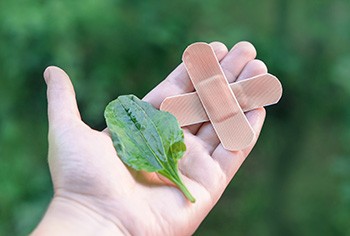
Among the effective uses of plantain is in developing a natural aversion to smoking. In a study, scientists discovered that chewing plantain leaves or consuming plantain tea decreases the body’s nicotine craving.
A spray of the tincture of plantain into the mouth during nicotine craving will also help. That is why they are the main ingredient in some commercially sold smoking cessation products.
Plantain is also used in treating respiratory symptoms. Consuming plantain tea will reduce mucus build-up and throat inflammation. A decoction of the plant’s roots can also lower the episode of asthma. Gargling dried plantain leaves tea can alleviate voice hoarseness and aphonia or damage to the larynx and mouth.
The plant is also a rich source of soluble fiber which can effectively reduce the cholesterol level. The coatings of the seeds or psyllium husks have high fiber making them an effective laxative for treating constipation. It is also an effective medicine to alleviate the pain in hemorrhoids.
Because of its anti-inflammatory property, the common plantain may also reduce menstrual bleeding. An extract of its leaves is taken to reduce the bleeding in people with menorrhagia or heavy menstrual bleeding.
For autoimmune conditions and other chronic diseases, try drinking Plantain Tea twice daily or take it in tincture form (note that the benefits build up over time). Just like Plantain works on your skin it also provides healing inside your gut. For Leaky Gut eat fresh leaves and drink it juiced or as a tea daily. A tincture is also effective but supplementing with fresh plantain or tea helps the plantain reach the gut lining for direct healing. It is beneficial for calming inflammation of the mucous membranes, including the membranes of the respiratory tract, digestive tract, and urinary tract. I use it as one of six herbs in the Balanced Gut Tincture, which can also be found in the Warrior Bundle.
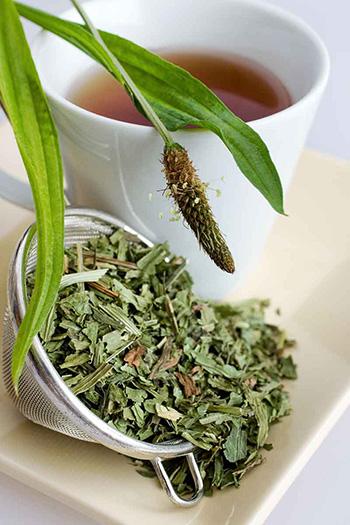
In brief, here are the illnesses that the plantain plant can cure:
- Cholesterol
- Diabetes
- Digestive issues (diarrhea, constipation, upset stomach, stomach ulcer)
- Fever
- Hemorrhoids
- Insect bites, mosquito bites
- Mouth sores and ulcers, bad breath, toothache
- Respiratory problems (common cold, bronchitis, asthma, cough, and phlegm)
- Snakebites
- Smoking
- Wounds
- Any inflammations
What Parts of the Plantain Is Used For Remedies?
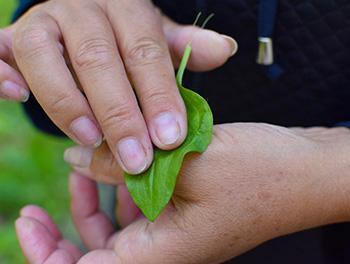 The leaves and the seeds of the plantain are the most valued part of the plant as herbal medicine. They are rich in vitamins and minerals like Vitamin A, C, and K to boost the immune system. It can also support eye health and promotes proper blood coagulation for faster wound healing.
The leaves and the seeds of the plantain are the most valued part of the plant as herbal medicine. They are rich in vitamins and minerals like Vitamin A, C, and K to boost the immune system. It can also support eye health and promotes proper blood coagulation for faster wound healing.
Sometimes, the roots of the plant are also used in preparing decoction.
Plantain leaves can be eaten raw or mixed into salads. Its raw form is the advisable way of consuming plantain to ensure better absorption of nutrients.
The greater plantain is also available in concentrated forms for medicinal purposes. They are sold in the form of capsules, tincture, oil, or ointment in some online stores and health shops.
Healing Plantain Tea
Ingredients:
- 1 tablespoon chopped fresh plantain leaves (or 1 tsp if using dried herb)
- 1 cup of water
- Honey, to taste
(You may increase the serving using the 1 tbsp or 1 tsp for every cup of water ratio)
Steps:
- If using fresh leaves, gather plantain leaves and wash them thoroughly before chopping them into small pieces.

- In a saucepan, put the water and plantain leaves together and bring to a boil.
- Turn off the heat and allow the plantain tea to steep for about 5 to 10 minutes. Cover.

Remove the leaves using a strainer and sweeten with honey if desired to alleviate the bitter flavor.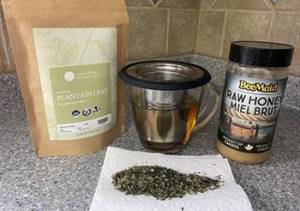
Consume plantain tea while it is warm three to six times a day until your symptoms are relieved.
When cooled, this plantain tea can also be used as a skin toner or for treating sunburn. You can put it in a spray bottle and spritz the plantain tea into the affected area for relief.
Plantain Compress To Relieve A Rash
Plantain makes a great all-round treatment for most rashes and skin conditions because of its anti-bacterial and anti-fungal abilities. It also has a cooling effect, so a plantain cold compress or wet wrap is ideal for people suffering from a rash.
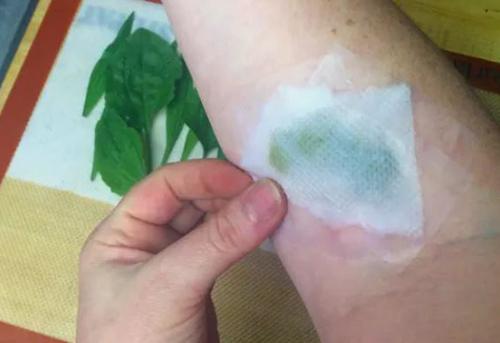
- Boil a pot of water, add a handful of plantain, cover, and brew it until it is cool.
- Strain and soak bandages in the tea, then wrap them around the affected area.
- For an extra cold compress put the tea and bandages in the fridge first, until they have chilled.
Rejuvenating Face Mask
- Fresh plantain leaves – 3-4 pcs.;
- Honey – 2 tsp;
- Olive or almond oil – 1 tsp
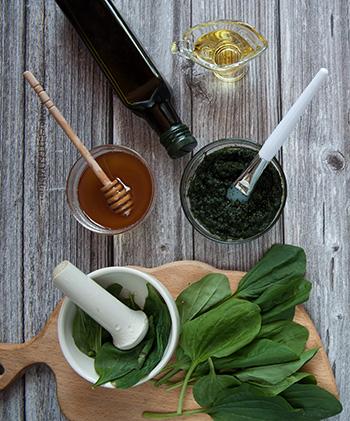 Grind the leaves, add liquid honey (you can melt it in a water bath) and vegetable oil.Having mixed the resulting mass well, gently apply the mask to the skin along the massage lines. Hold for a quarter of an hour. Remove the rest of the mask with a cotton pad and wash off with warm water.
Grind the leaves, add liquid honey (you can melt it in a water bath) and vegetable oil.Having mixed the resulting mass well, gently apply the mask to the skin along the massage lines. Hold for a quarter of an hour. Remove the rest of the mask with a cotton pad and wash off with warm water.
Fresh plantain leaves are an excellent remedy for sunburn: relieves pain and redness, promotes cell regeneration. To do this, gruel from fresh crushed leaves is applied to damaged skin for 15-20 minutes. Wash with cool boiled water. Plantain is used in cosmetology not only for the face, it is an excellent remedy for cracked dry skin of the hands, improves hair structure, is a part of creams and gels.
What Plants Resemble Plantain
| Feature | Broadleaf Plantain (Plantago major) | Hosta (Hosta sieboldiana) |
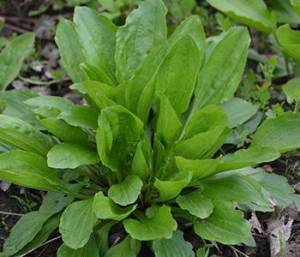 |
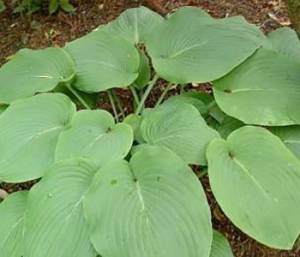 | |
| Size | Up to 70 cm | 15 to 90 cm |
| Leaves | Rosulate; elliptical; green; hairy lower surface | Rosulate; elliptical; green/blue; hairless |
| Flowers | Clustered in spike; greenish-brown with purple stamens | Hairpin-like flowers; white/lilac with leafy bracts |
| Stem/Trunk | Herbaceous; straight and round; smooth; green | Herbaceous; upright; hairy |
| Scent | No scent | No fragrance |
Warnings And Cautions
Plantain is safe for both internal and external applications. However, users of this product need to be aware of sensitivity or allergic reactions. It may worsen the symptoms in people with severe hay fever.
Plantain is likely safe for consumption in its natural form, like tea or decoction. However, plantain food supplements may be potent and affect the absorption of medications. The Vitamin K content of the plant may also interact with Warfarin or drugs used to slow down blood clotting and decrease its action. It is always advisable to check with the doctor before taking any natural herb and supplements.
Pregnant women should not use plantain as an herbal remedy as it might affect the uterus and cause miscarriage. Its safety in breastfeeding women is not yet established so, it is better to avoid using it to always be safe.
10 Remedies You Can Make Using Plantain
A Natural DIY Antibiotic Salve Recipe to Keep Around (Video)
How to Make Anti-Inflammatory Band-Aid Using Plantain
Healthy Pringles: The Nutritious Leaves That Make Crispy Chips








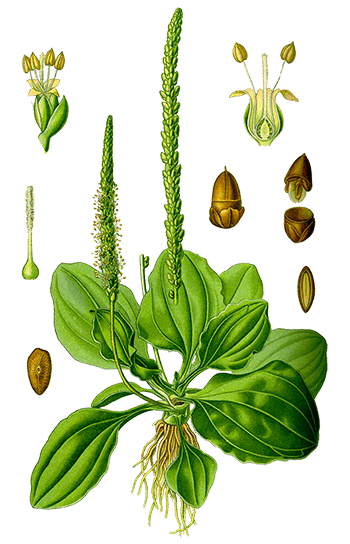 Flower. Greater plantain has a cylindrical spike on top of its stem that grows small flowers. These flowers are greenish-brownish in color and with either white or purple stamens. It is narrow and cylindrical, densely clustered in the center of its spike.
Flower. Greater plantain has a cylindrical spike on top of its stem that grows small flowers. These flowers are greenish-brownish in color and with either white or purple stamens. It is narrow and cylindrical, densely clustered in the center of its spike.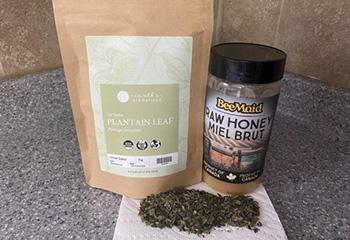
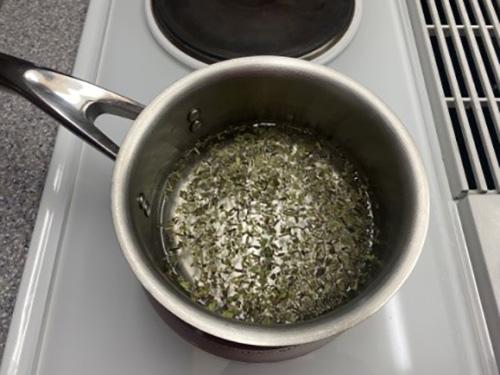
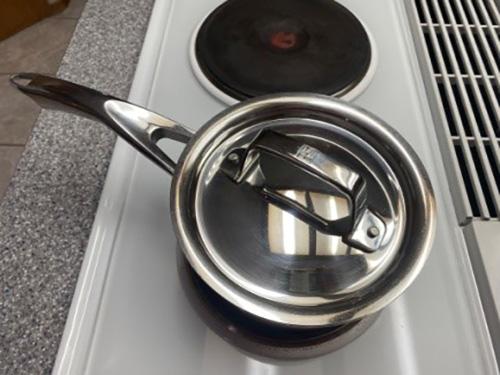
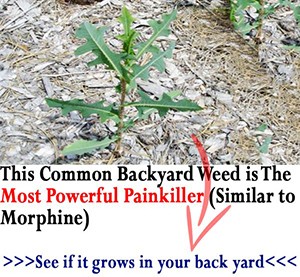
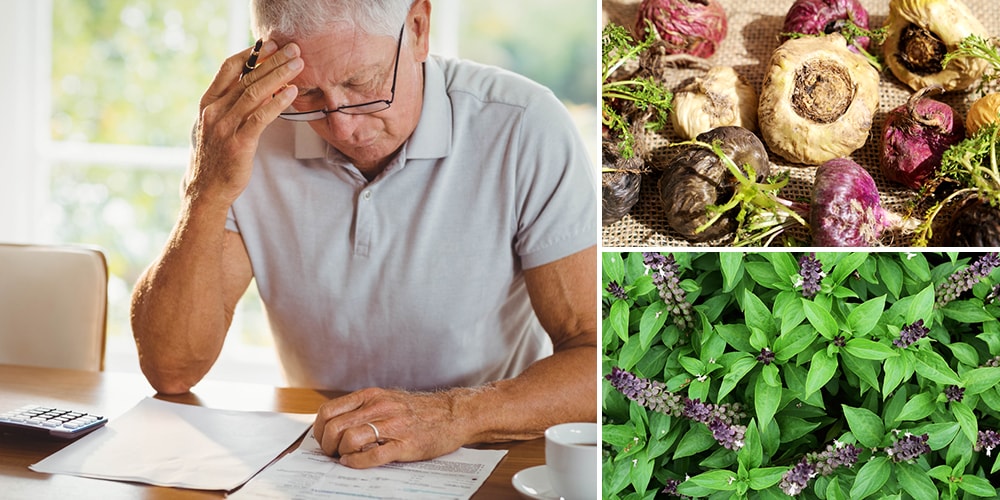
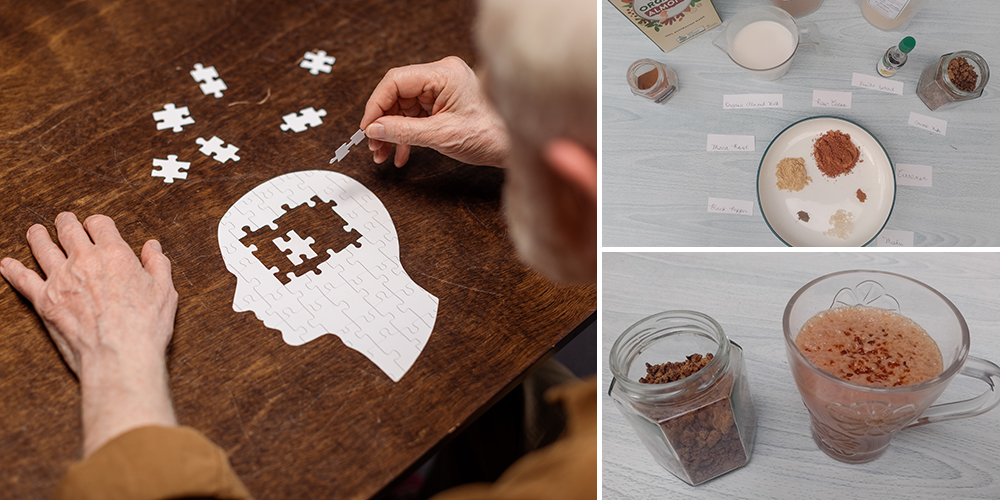
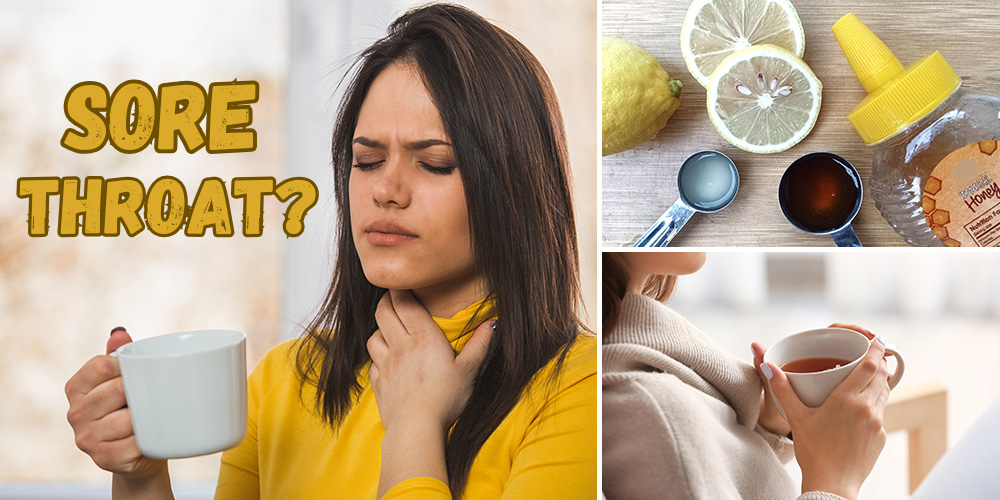
I’m glad to receive this info and will send the site to my friends and family members, thank you
This is amazing. As a child I would play with this plant and was fascinated with the fibrous stems.
A favourite! I make a salve of the leaves (first oil and then wax to make the salve) and I have healed many problems and ailments =)
I have narrow leaf plantain where I live. Are the benefits the same with the narrow leaf vs broad leaf?
Its probably plantago lanceolata and as far as I know, it does 🙂
Thank you very much-I looked it up and found a study done on this plant and found my answer 😉
Great info! We have the book and a new appreciation for many things once thought of as weeds. Thank you and we continue to share.
I’m going to harvest plantain, and have some tea, greens for my cooker, and, vitamin K, to pair up with, vitamin E.
I used it for eczema. Leaves and a little vegetable oil in blender. Applied paste to skin and wrapped with bandage. I would let it stay all night while I slept and skin already trying to heal by morning.
Good info. I make a deep healing salve with other herbs plus plantain added. My friend used it on her diabetic food wound and healed it. Her doctor was amazed and wanted to know more about the herbs which I thought was great that he showed interest in herbs along with his traditional methods.
I see it every day on my walks. Time to harvest some and dry to add to my herbal apothecary.
…as far as I know the dry leaves are not so good (or not good at all ) in compare to the fresh, so I freeze them or make oils and tinctures of them, just hours after I picked them =)
Molly, i use the fresh when its available but i also have bought large quantities of dried plantain and made a salve with it (and calendula and chamomile. Finished off with lavender oil. It is superior at taking swelling and itch out of bug bites and healing small cuts, wounds, rashes very fast. So i would argue that dry is also useful if you keep it sealed in plastic
Bag.
I have always been interested and herbs and I love learning about them I wished I could go to school for it
There are so many great herbal classes on line! I’ve enrolled in two (Herbal Academy and Trinity School of Natural Health) both have been wonderful. Sometimes they will do a special and offer classes at a discount. There is also Rooted Medicine Circle. But so many others!!!
There’s also research showing that a variety of Plantago species have cytotoxic and anti-proliferative effects against various cancers, including breast cancer. :-> https://www.researchgate.net/publication/5277578_Cytotoxic_effect_of_Plantago_spp_on_cancer_cell_lines
Another study also shows similar effects for various breast cancers, including triple negative: https://pubmed.ncbi.nlm.nih.gov/32372137/
Thanks so much, Nicole, for such a wonderful & valuable website!
I am a desert combat vet. If my Uncle Sam didn’t bring the beans (food and water) and bullets (security and safety), I would have been a dead-duck in days. I also worked with people (usually women with mean boyfriends) who were ready to run out the back door “to the hills” with any strange noise out their main door. If anyone knows what hill they would run towards, it would be smart to be a “Johnny Appleseed” (a 1700’s man, who planted appleseeds along the trails from Appalachians to KY to Mississippi River). Plaintain, dandelions, any edible weeds will grow just about everywhere, and especially plantain. So, if you would ever run (probably with little supplies), plantain seeds are easy to store (for a hiking day to your favorite outdoor rest area). Plant the seeds (but not where anyone is spraying weeds). Then if you ever need to make an emergency trip, you have food along the way (even in winter, even with snow on the ground. My state connects with Canada). If you have a cabin somewhere, plant plantain around it. If you have a favorite campground, plant plantain and other edibles (and teach your grandchildren about it) I told a friend that if the grocery stores were empty, the first thing I would do is start digging and eating off my lawn–dandelions, plantain, purslane in areas, clover, alfalfa, etc. And if my neighbors were hungry, I’d invite them to bring a shovel and dig their own leaves and roots. Would anyone do that? No. Would they rob me for the dandelions I brought into my house to cook and eat? I doubt it, and especially if I am out there digging every day. Really, it took me about 10 minutes walking my yard to pick 300+ plantain seeds; and if I was walking a trail, I could drop seeds, step on them (they are hard seeds) and in another year or so, there would be lots of plantain, and/or other edibles. Heck! If you have guests at your cabin that you can’t wait for them to leave, serve a casserole of plantain.
ok this mask recipe is not clear… can you look at it again and edit?
“Fresh plantain leaves – 3-4 pcs.;
Honey – 2 tsp; Olive or almond oil
1 tsp Grind the leaves, add liquid honey (you can melt it in a water bath)
vegetable oil.”
You need only fresh leaves ? then they are pulverized in a mortar or small food processor? then you measure 1 tsp of that? then you add 2 tsp honey and how much oil? why is vegetable oil there as well as the other oils..?
I used plantain to cure poison ivy (in my case, overnight). I put a lot of them in a blender with a bottle of alcohol. Ground that up and dripped it through a coffee filter back into the alcohol bottle. Refrigerated it keeps a VERY long time. I used cotton balls to swab my patches of poison ivy and the itch stopped immediately. As the itch came back, I applied the mixture again, and by the next day the poison ivy patches were gone!
By “a lot of them” I meant a lot of leaves, as many as I could cram into the blender.
Great information. I would highly recommended adding a disclaimer that Herbal remedies cannot cure a venomous snake bite and can only help treat the symptoms. If someone is bit by a venomous snake they need to seek prompt medical care and to receive antivenin (the only antidote to envenomation) if available.
That depends on where the venomous snake bit you.